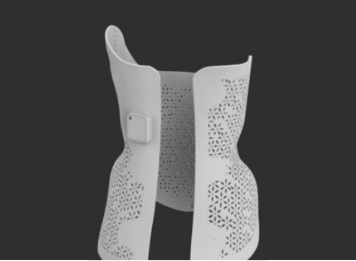Scoliosis is a condition where the spine curves abnormally into an "S" or "C" shape, commonly seen in children and adolescents. Traditional treatment methods include the use of orthopedic braces or, in severe cases, surgery. However, conventional braces are often manufactured based on standard sizes, leading to discomfort, low accuracy, and limited treatment effectiveness. Moreover, manually crafting braces is not only time-consuming but also struggles to meet the specific needs of each patient.
The role of the MQ 3D scanner in scoliosis treatment
The MQ 3D scanner, developed by 3DEVOK, is an advanced tool that uses structured light scanning technology to create extremely precise three-dimensional digital models of the patient’s body. This technology offers outstanding benefits:

High accuracy: The MQ 3D scanner can capture the patient’s body shape with millimeter-level precision. This is especially important in designing orthopedic braces, as a perfectly fitting brace significantly improves spinal correction effectiveness and increases patient comfort.
Non-invasive and fast: The 3D scanning process does not require physical contact, making patients, especially children, feel much more at ease. A scan takes only a few minutes, greatly shortening the time needed to collect geometric data.
Flexible digital data: The scan data is converted into a 3D model, easily used in computer-aided design (CAD) software to create customized braces. This data can also be stored to closely monitor the patient’s progress over time.
TPM3D 3D printing: From digital model to personalized brace
After collecting data from the MQ 3D scanner, the next step is to use the TPM3D 3D printer to produce the orthopedic brace. This 3D printing technology offers significant advantages over traditional manufacturing methods:
Optimal personalization: The TPM3D 3D printer enables braces to be produced based on the individual 3D scan data of each patient. This ensures that the brace perfectly matches the body shape, reducing pressure on sensitive areas and enhancing corrective effectiveness.
Lightweight and durable materials: 3D-printed braces are made from advanced materials such as medical-grade plastics or composites, considerably lighter than traditional braces while still ensuring the necessary strength and spinal support.
Fast production time: With 3D printing, the time to produce a brace is greatly reduced, from several weeks down to just a few days. This allows patients to receive their orthopedic device sooner, accelerating the treatment process.
Aesthetic and comfortable designs: 3D-printed braces can be designed with ventilation holes to increase comfort and reduce skin irritation. Designers can also add aesthetic elements, helping patients, especially children, feel more confident when wearing them.
Step 1: 3D body scanning: Use the MQ 3D scanner to capture the body shape, focusing on the spine and chest areas. This data is then converted into a digital 3D model.
Step 2: Brace design: The 3D model is imported into CAD software, where doctors and engineers work closely to design the brace best suited to the patient’s scoliosis condition. Factors such as curvature, pressure points, and support areas are all optimized.
Step 3: 3D printing the brace: The TPM3D 3D printer uses the design data to produce the brace with high precision. After printing, the brace is carefully inspected and fine-tuned.
Step 4: Testing and adjustments: The patient tries on the brace and provides feedback. If needed, minor adjustments can be made quickly thanks to the superior flexibility of 3D printing technology.

Practical applications
MQ 3D scanning and TPM3D 3D printing technologies have been successfully applied in many real cases. For example, numerous children with mild to moderate scoliosis have benefited from lighter, more comfortable braces that deliver clearly improved treatment outcomes. Hospitals and clinics worldwide are gradually integrating these technologies to provide personalized treatment solutions.
Although 3D scanning and 3D printing technologies bring many benefits, there are still some challenges to overcome. The initial investment cost for high-quality 3D scanners and 3D printers can be a barrier, especially for small healthcare facilities. Additionally, training medical staff to effectively use these technologies is an important factor to consider. However, as technology becomes more widespread, costs are expected to decrease, and these solutions will become more accessible to many.
The combination of 3D scanning and 3D printing can also expand into many other medical fields, such as manufacturing prosthetics, other orthopedic support devices, or even detailed anatomical models to assist in planning complex surgeries. For scoliosis, these technologies promise to continue improving patients’ quality of life through highly personalized and superior solutions.
The MQ 3D scanning and TPM3D 3D printing technologies from 3DEVOK are reshaping the approach to scoliosis treatment, ending the “one-size-fits-all” method. By providing fully personalized orthopedic braces, this technology not only enhances treatment effectiveness but also brings comfort and confidence to patients. As cost and technical barriers are overcome, we can expect these advanced solutions to become the gold standard in treating scoliosis and other orthopedic conditions.
On June 25, shares of the American semiconductor giant Nvidia officially set a new record, rising by 4.3% to close at $154.3 per share. This surge pushed Nvidia’s market capitalization to $3.77 trillion, allowing the company to surpass Microsoft and reclaim its position as the world’s most valuable company by market cap.
View moreIn the context of digital transformation and the adoption of advanced technologies in manufacturing, 3D scanners have become a key tool that helps businesses save time and costs while enhancing accuracy in design and quality inspection. Below is a list of some of the most notable affordable genuine 3D scanner models currently available, well-suited for small and medium-sized enterprises in Vietnam.
View more